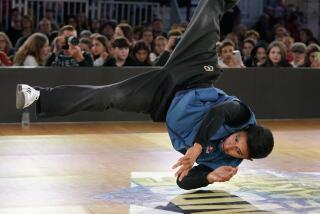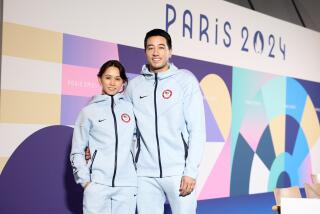Like a Rock : Curling: It’s Not Just a Canadian Sport Anymore
- Share via
It requires a strong body and a nimble mind. Its roots are deep in 16th century Scotland.
And it’s played with a rock and a broom.
The ancient game of curling debuts as a full-medal sport in the Winter Olympics in Nagano next year. The U.S. team begins taking shape in Seattle March 1, when the Granite Curling Club plays hosts to the national curling championships.
The top four teams--two men’s and two women’s--win berths for Olympic qualifying in December.
“It’s a mentally challenging game--a lot like golf,” said Seattle’s Travis Way, the U.S. junior national curling champion and a 1996 U.S. Olympic Committee athlete of the year. “There are days when it’s easy, and days when it’s hard.”
Curling, played on an ice rink, involves two teams of four people each, who take turns sliding 42-pound granite stones 160 feet down a marked sheet of ice toward a bull’s eye target.
A game is called a “bonspiel,” which usually consists of 10 “ends” or innings. Curling gets its name from the “curl” or spin a player puts on the stone.
Each player has two stones to use at each end. The team whose player ends up with any of stones closest to the center of the target, both within the bulls eye and closer than the opponent’s stones, gets the points. Players aid the travel of the stones by sweeping the ice with special brooms.
Those who believe curling was long overdue for recognition as an Olympic sport owe a debt of gratitude to Sophie Wallace and her husband, Thomas, who call themselves the World Curling Federation’s “curling ambassadors to Iceland.”
The Wallaces, originally from Winnipeg, Manitoba, were instrumental in persuading Iceland to field a curling team for the Olympics. A minimum of 25 countries were needed to get the game in the Games, and Iceland was country No. 25.
“This was a country with the perfect name for this game,” Mrs. Wallace said, yet curling was almost unknown in Iceland.
Curling is most closely identified with Canada, where 1.25 million people enjoy the sport. By contrast, the United States has about 15,000 curlers in 135 clubs in 26 states.
“I do this because I wasn’t big enough or fast enough to play football,” said Dale Risling, 35, of Everett, whose father, Ed, was a 1975 national champion curler and a runner-up in the world competition.
David Garber, director of the U.S. Curling Association in Stevens Point, Wis., expects the number of curling enthusiasts to jump with the Olympics.
“I think the real increase will be after curling is seen on TV,” he said.
Mary Anderson, 38, has been curling for a dozen years at the Seattle club.
“I fell in love with it the first night even though I spent most of the time sitting on the ice,” she recalled. “I met my husband out here.”
More to Read
Go beyond the scoreboard
Get the latest on L.A.'s teams in the daily Sports Report newsletter.
You may occasionally receive promotional content from the Los Angeles Times.






